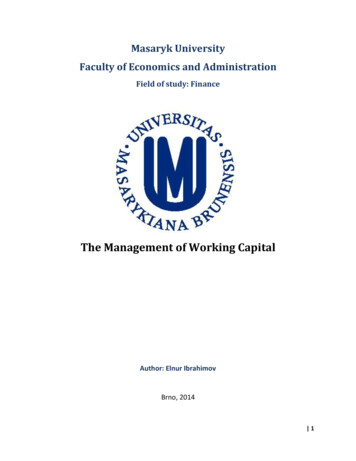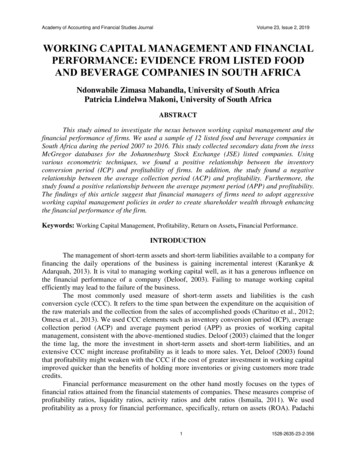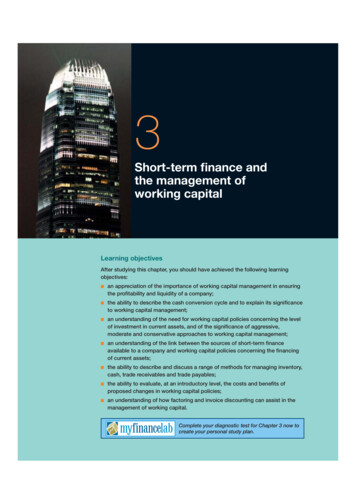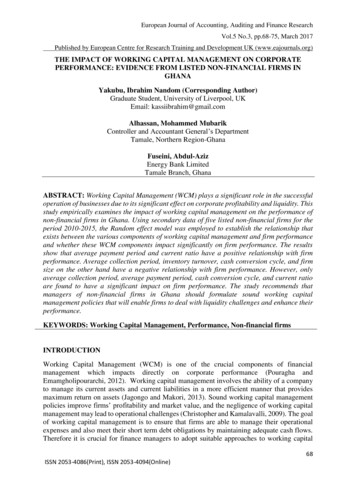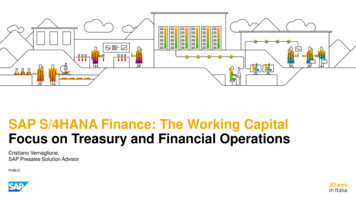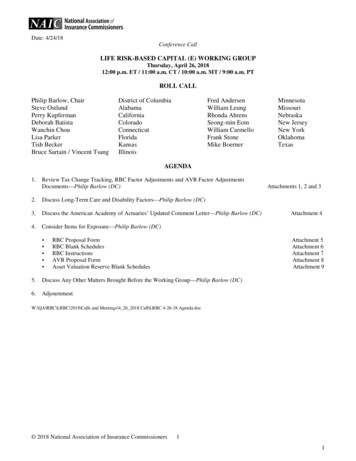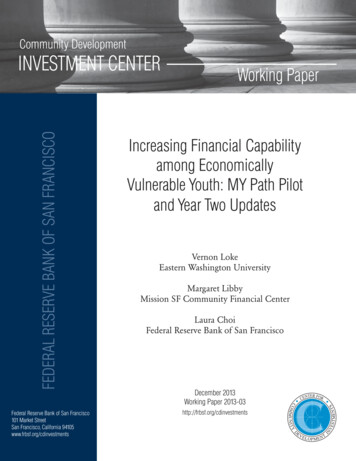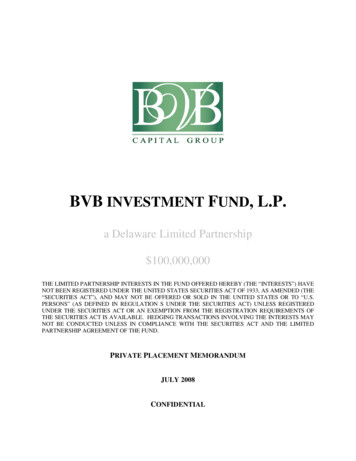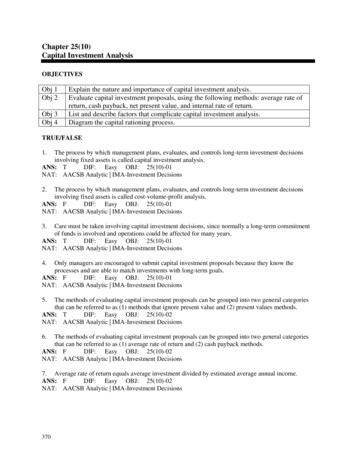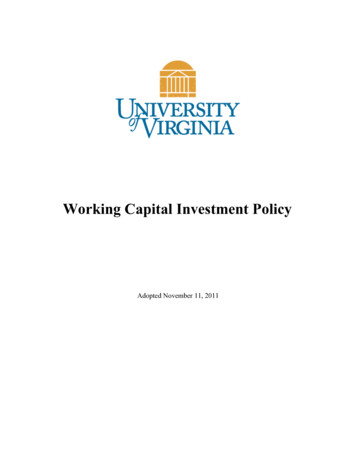
Transcription
Working Capital Investment PolicyAdopted November 11, 2011
Table of ContentsI. Governing Authority . . . 3II. Scope . . . . . . .3III. General Objectives . . . .4Tier StructureSafetyLiquidityYieldIV. Standards of Care .5PrudenceEthics and Conflicts of InterestDelegation of AuthorityV. Custody, Trust, and Controls .6Custody /TrustInternal ControlsVI. Authorized Investments 6Permitted InvestmentsVII. Portfolio Risk Management 8Interest Rate RiskCredit RiskLiquidity RiskVIII. Investment Parameters & Diversification . 9Portfolio DiversificationSubsequent EventsIX. Selection of Broker/Dealers, Investment Managers and Depository Banks . 10Selection of Broker/DealersEngagement of Investment ManagersSelection of Depository BanksX. Prohibited Investments and Investment Practices . .12XI. Portfolio Benchmarks . .13
Appendix A:University of Virginia Investment Management Company Investment Policy StatementAppendix B:Board of Visitors resolution, October 2007
I.Governing AuthorityBoard of Visitors resolution, October 2007 (attached as Appendix B)RESOLVED that the Vice President and Chief Financial Officer is authorized to investthe cash of and held by the University in the University of Virginia InvestmentManagement Company (UVIMCO) long-term pool or in other investment vehicles aspermitted by law, the cash to include but not be limited to working capital, operatingreserves, employee health plan reserves, other academic division operating and capitalreserves, and medical center working capital, operating and capital reserves includingdepreciation reserves;Definition of Working Capital“Working Capital” is the operating liquidity available to an organization to meetfinancial obligations.The University’s investment program shall be operated in conformance with applicablefederal, state, and other legal requirements, including, but not limited to, that certainManagement Agreement dated November 15, 2005, by and between the Commonwealthof Virginia and The Rector and Visitors of the University of Virginia, as amended(Chapter 3 of Chapter 943 of the 2006 Virginia Act of Assembly) (including Exhibit R,Policy Governing Financial Operations and Management, thereto); the Security forPublic Deposits Act, Chapter 44 (§ 2.2-4400 et seq.) of Title 2.2 of the Code of Virginia,as amended; the Investment of Public Funds Act, Chapter 45 (§ 2.2-4500 et seq.) of Title2.2 of the Code of Virginia, as amended; the Uniform Prudent Management ofInstitutional Funds Act, Chapter 15, Article 1.2 (§ 55-268.11 et seq.) of Title 55 of theCode of Virginia, as amended; and § 23-76.1 of the Code of Virginia, as amended,concerning the University’s investment of endowment funds, endowment income, andgifts.II.ScopeThe purpose of this policy is to set forth the investment and operational policies for theUniversity’s Working Capital Funds. Proceeds from tax-exempt bond issues,endowment assets, and money held in bank demand deposit accounts are not coveredunder this policy.Except for cash in certain legally restricted and special accounts, the University willconsolidate cash and reserve balances to optimize University-wide liquiditymanagement and investment earnings and to increase efficiencies with regard toinvestment pricing, custody/trust and administration.3
III.General Objectives & Investment GuidelinesThe primary objectives of the policy are to set investment parameters, establish limitsconsistent with the University’s risk tolerance, and provide appropriate benchmarks forperformance.Tier Structure - For purposes of this policy, the University’s Working Capital Fundsshall be divided into three (3) Tiers based on expected liquidity needs and returnobjectives. Investment activities for all Tiers shall be guided by the objectives of safety,liquidity and return. The priority of these objectives will vary based on Tier as describedbelow.1. Safety - Safety of principal is an important objective of the University’s investmentprogram. Investments shall be undertaken in a manner that seeks to ensure thepreservation of capital in the overall portfolio by mitigating credit risk and interestrate risk.2. Liquidity - The investment portfolio shall remain sufficiently liquid to meet alldisbursement requirements that may be reasonably anticipated in the Tier.3. Return - The investment portfolios shall be designed with the objective of attaininga market rate of return throughout budgetary and economic cycles. Performanceobjectives will be established for each Tier consistent with stated objectives.Tier 1: The University’s cash and short-term investments shall be categorized as the Tier1 Portfolio. Because of the difficulties inherent in accurately forecasting cash flowrequirements, a portion of this portfolio shall be continuously invested in readilyavailable funds such as money market mutual funds, bank deposits, or overnightrepurchase agreements to ensure that appropriate liquidity is maintained to meet theUniversity’s obligations. Safety and liquidity are the primary objectives of this Tier.Tier 2: The Tier 2 Portfolio represents Working Capital Funds that do not need to bereadily available to meet the University’s operating needs. These funds are available forintermediate-term investment. Safety and return are the primary objectives of this Tier.Tier 3: The Tier 3 Portfolio represents Working Capital Funds that can be invested aspart of the commingled pool managed by the University of Virginia InvestmentManagement Company (“UVIMCO”). The Investment Policy Statement for UVIMCOgoverns Tier 3 assets and supersedes the limits set forth in this policy for assetallocations and issuer limitations. (A copy of the UVIMCO Investment Policy Statementis included as an appendix to this policy and incorporated by reference.) The primaryobjective of this Tier is to maximize long-term real return commensurate with the risktolerance of the University.The University’s liquidity needs, cash forecast, and risk tolerance will be considered indetermining what percentage of total working capital will be invested in Tier 1. Assets4
invested in Tier 2 are those assets typically not needed during the University’s annualoperating cycle. Tier 2 assets are typically those assets being held for specific projectsexpected to be needed over a 1-5 year time frame. The remaining working capital,primarily in the form of reserves, will be allocated to the Tier 3 portfolio. Allocationamong the three tiers will be monitored regularly and reported annually to the Board ofVisitors.IV.Standards of Care1. Prudence - The standard shall be the "prudent person" standard, except as mayotherwise be prescribed by applicable laws or regulations now or in the future. Underthe "prudent person" standard, investments shall be made with the care, skill,prudence and diligence under the circumstances then prevailing that a prudent personacting in a like capacity and familiar with such matters would use in the conduct of anenterprise of a like character and with like aims.Investment officers acting in accordance with written procedures and this investmentpolicy and exercising due diligence in good faith shall be relieved of personalresponsibility for an individual security's credit risk or market price changes,provided deviations from expectations are reported in a timely fashion.2. Ethics and Conflicts of Interest - The University’s officers and employees involvedin the investment process shall refrain from personal business activity that couldconflict with the proper execution and management of the investment program, orthat could impair their ability to make impartial decisions or otherwise be in violationof state law and/or University policy.3. Delegation of Authority - Authority to manage the investment program in accordancewith this investment policy is granted to the University’s Vice President and ChiefFinancial Officer, who shall act and may further delegate in accordance with anyprocedures and internal controls for the operation of the investment programconsistent with this investment policy. The Executive Vice President and ChiefOperating Officer and the Vice President and Chief Financial Officer may maketemporary exceptions to the investment policy in the event of significant marketinstability or a credit event that would require us to make a significant reallocation ofthe portfolio in order to protect the safety and/or liquidity of the working capitalportfolio. Any such exception to the investment policy will be reported immediatelyto the Rector and Chair of the Finance Committee of the Board of Visitors. Anytemporary exception will remain in place until no later than the next Board of Visitorsmeeting at which time the EVP and COO will suggest a course of action with regardto the policy and seek input on and approval of such action by the Board.5
V.Custody, Trust, and Controls1. Custody/Trust - The University will not take physical possession of investmentsecurities. Securities will be held by an independent third-party custodian selected bythe University as evidenced by custody/trust receipts in the University’s name. Thecustody/trust institution shall annually provide a copy of their most recent report oninternal controls (Statement of Auditing Standards No. 70, or SAS 70).2. Internal Controls - Treasury Management is responsible for establishing andmaintaining an internal control structure designed to ensure that the assets of theUniversity are protected from loss, theft, or misuse.VI.Authorized InvestmentsPermitted investments - The University may invest in the following investment vehiclessubject to diversification and maturity limitations for each Tier.1. U.S. Treasury Obligations - Bills, notes, and any other obligation or security issuedby or backed by the full faith and credit of the United States Treasury.2. Federal Agency Obligations - Bonds, notes, and other obligations of the UnitedStates, and securities issued by any federal government agency or instrumentality orgovernment sponsored enterprise that has a rating no less than the rating on U.S.Government debt. Collateralized mortgage obligations will not be purchased.3. Negotiable Certificates of Deposit, Bank Deposit Notes and Non-NegotiableCertificates of Deposit / Time Deposits - Negotiable and non-negotiable certificatesof deposit, time deposits and negotiable bank deposit notes of domestic banks anddomestic offices of foreign banks with a rating of at least A-1 by Standard & Poor’s,Inc., and P-1 by Moody’s Investor Service, Inc., for maturities of one year or less, anda rating of at least AA by Standard & Poor’s, Inc., and Aa by Moody’s InvestorService, Inc., for maturities over one year.4. Bankers’ Acceptances - Issued by domestic banks or domestic offices of foreignbanks, which are eligible for purchase by the Federal Reserve System with a maturityof 180 days or less. The issuing corporation, or its guarantor, must have a short-termdebt rating of no less than “A-1” (or its equivalent) by at least two of the NationallyRecognized Statistical Rating Organizations (“NRSRO’s”).5. Corporate Debt - High quality corporate notes with a rating of at least Aa byMoody's Investors Service, Inc., and a rating of at least AA by Standard and Poor’s,Inc.6. Commercial Paper - “Prime quality” commercial paper, with a maturity of 270 daysor less, issued by domestic corporations (corporations organized and operating under6
the laws of the United States or any state thereof) provided that the issuingcorporation, or its guarantor, has a short-term debt rating of no less than “A-1” (or itsequivalent) by at least two of the NRSRO’s.7. Municipal Obligations - Bonds, notes, and other general obligations of a municipalauthority organized within the United States upon which there is no default andhaving a rating of at least AA by Standard & Poor’s, Inc., and Aa by Moody’sInvestor Service, Inc.8. Repurchase Agreements - Overnight, term, and open repurchase agreementsprovided that the following conditions are met:1. the contract is fully secured by deliverable U.S. Treasury and federal agencyobligations as described above, having a market value at all times of at least 102percent of the amount of the contract;2. a master repurchase agreement or specific written repurchase agreement governsthe transaction and which in each case contains terms qualifying each transactionas a securities loan for purposes of Section 512 under the Internal Revenue Code,and provides for master netting of obligations;3. the securities are free and clear of any lien and held by an independent third-partycustodian acting solely as agent for the University, provided such third party isnot the seller under the repurchase agreement;4. a perfected first security interest under the Uniform Commercial Code inaccordance with book entry procedures prescribed at 31 C.F.R. 306.1 et seq. or 31C.F.R. 350.0 et seq. in such securities is created for the benefit of the University;such that the agent holding the underlying securities (the collateral) must hold thesecurities in a way that ensures they remain the property of the University.5. for repurchase agreements with terms to maturity of greater than one day, theUniversity will have the collateral securities valued daily and require that ifadditional collateral is warranted, then that collateral must be delivered within onebusiness day (if a collateral deficiency is not corrected within this time frame, thecollateral securities will be liquidated);6. the counterparty is a:a. primary government securities dealer who reports daily to the Federal ReserveBank of New York, orb. a bank, savings and loan association, or diversified securities broker-dealerhaving at least 5 billion in assets and 500 million in capital and sub
Tier Structure - For purposes of this policy, the University’s Working Capital Funds shall be divided into three (3) Tiers based on expected liquidity needs and return objectives. Investment activities for all Tiers shall be guided by the objectives of safety, liquidity and return. The priority of these objectives will vary based on Tier as described

